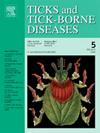下载PDF
{"title":"描述 Rhipicephalus hibericus sp.","authors":"Javier Millán , Ruth Rodríguez-Pastor , Agustín Estrada-Peña","doi":"10.1016/j.ttbdis.2024.102340","DOIUrl":null,"url":null,"abstract":"<div><p>We describe all the life stages of <em>Rhipicephalus hibericus</em> n. sp., provide the types, and present molecular support for a new species of the <em>Rhipicephalus sanguineus</em> sensu lato group, present in southwestern Europe, that has been historically confused with <em>Rhipicephalus turanicus</em> Pomerantzev, 1940. A new name is proposed for this taxon because it was impossible to ascribe to types of already described species in the group, deposited for more than 100 years in natural history institutions. The males have a dorsum showing deep and coarse punctations (absent in <em>Rhipicephalus sanguineus</em> sensu stricto) and adanal plates with large punctations (absent in <em>R. sanguineus</em> s.s.); the tail of the spiracular plate is as wide as the closest festoon (half the width in <em>R. sanguineus</em> s.s.). Females have large punctations in dorsal fields, a wide spiracular plate, and a “V” shaped genital opening; such a combination of characters cannot be found in other species of the group. Immatures are described from specimens collected on hosts (Rodentia and Eulipotyphla). Both larvae and nymphs are markedly smaller than <em>R. sanguineus</em> s.s. Nymphs display long, backward-projected auriculae; larvae are almost half the size of <em>R. sanguineus</em> s.s. The new species can hybridize with <em>R. sanguineus</em> s.s. in laboratory colonies producing an unfertile F2, laying brown and dry eggs that did not hatch. Phylogenetic analysis of partial <em>coxI</em> gene sequences placed <em>R. hibericus</em> in a well-supported clade with other sequences of <em>R. sanguineus</em> s.l. from Portugal, as a sister clade of <em>R. sanguineus</em> s.s. The new species does not belong to the <em>R. turanicus</em> group of species. Both <em>12S</em> and <em>16S</em> partial gene sequences were not as precise in the correct phylogenetic placement of <em>R. hibericus</em>, in part probably due to the existence of erroneously identified sequences in GenBank©. This description, together with the previous reinstatement of <em>Rhipicephalus secundus</em> and <em>Rhipicephalus rutilus</em>, and the description of the neotypes of <em>R. sanguineus</em> s.s. should help researchers to adequately identify their collections. Our findings demonstrate that <em>R. turanicus</em> is absent in southwestern Europe. Old collections should be re-examined to provide the actual range of the new species.</p></div>","PeriodicalId":49320,"journal":{"name":"Ticks and Tick-borne Diseases","volume":"15 4","pages":"Article 102340"},"PeriodicalIF":3.1000,"publicationDate":"2024-04-06","publicationTypes":"Journal Article","fieldsOfStudy":null,"isOpenAccess":false,"openAccessPdf":"https://www.sciencedirect.com/science/article/pii/S1877959X24000335/pdfft?md5=773b5280ea7bd8e4f38c8e9c62c63bd0&pid=1-s2.0-S1877959X24000335-main.pdf","citationCount":"0","resultStr":"{\"title\":\"Description of Rhipicephalus hibericus sp. nov. (Ixodoidea: Ixodidae), a species of the Rhipicephalus sanguineus group in southwestern Europe\",\"authors\":\"Javier Millán , Ruth Rodríguez-Pastor , Agustín Estrada-Peña\",\"doi\":\"10.1016/j.ttbdis.2024.102340\",\"DOIUrl\":null,\"url\":null,\"abstract\":\"<div><p>We describe all the life stages of <em>Rhipicephalus hibericus</em> n. sp., provide the types, and present molecular support for a new species of the <em>Rhipicephalus sanguineus</em> sensu lato group, present in southwestern Europe, that has been historically confused with <em>Rhipicephalus turanicus</em> Pomerantzev, 1940. A new name is proposed for this taxon because it was impossible to ascribe to types of already described species in the group, deposited for more than 100 years in natural history institutions. The males have a dorsum showing deep and coarse punctations (absent in <em>Rhipicephalus sanguineus</em> sensu stricto) and adanal plates with large punctations (absent in <em>R. sanguineus</em> s.s.); the tail of the spiracular plate is as wide as the closest festoon (half the width in <em>R. sanguineus</em> s.s.). Females have large punctations in dorsal fields, a wide spiracular plate, and a “V” shaped genital opening; such a combination of characters cannot be found in other species of the group. Immatures are described from specimens collected on hosts (Rodentia and Eulipotyphla). Both larvae and nymphs are markedly smaller than <em>R. sanguineus</em> s.s. Nymphs display long, backward-projected auriculae; larvae are almost half the size of <em>R. sanguineus</em> s.s. The new species can hybridize with <em>R. sanguineus</em> s.s. in laboratory colonies producing an unfertile F2, laying brown and dry eggs that did not hatch. Phylogenetic analysis of partial <em>coxI</em> gene sequences placed <em>R. hibericus</em> in a well-supported clade with other sequences of <em>R. sanguineus</em> s.l. from Portugal, as a sister clade of <em>R. sanguineus</em> s.s. The new species does not belong to the <em>R. turanicus</em> group of species. Both <em>12S</em> and <em>16S</em> partial gene sequences were not as precise in the correct phylogenetic placement of <em>R. hibericus</em>, in part probably due to the existence of erroneously identified sequences in GenBank©. This description, together with the previous reinstatement of <em>Rhipicephalus secundus</em> and <em>Rhipicephalus rutilus</em>, and the description of the neotypes of <em>R. sanguineus</em> s.s. should help researchers to adequately identify their collections. Our findings demonstrate that <em>R. turanicus</em> is absent in southwestern Europe. Old collections should be re-examined to provide the actual range of the new species.</p></div>\",\"PeriodicalId\":49320,\"journal\":{\"name\":\"Ticks and Tick-borne Diseases\",\"volume\":\"15 4\",\"pages\":\"Article 102340\"},\"PeriodicalIF\":3.1000,\"publicationDate\":\"2024-04-06\",\"publicationTypes\":\"Journal Article\",\"fieldsOfStudy\":null,\"isOpenAccess\":false,\"openAccessPdf\":\"https://www.sciencedirect.com/science/article/pii/S1877959X24000335/pdfft?md5=773b5280ea7bd8e4f38c8e9c62c63bd0&pid=1-s2.0-S1877959X24000335-main.pdf\",\"citationCount\":\"0\",\"resultStr\":null,\"platform\":\"Semanticscholar\",\"paperid\":null,\"PeriodicalName\":\"Ticks and Tick-borne Diseases\",\"FirstCategoryId\":\"3\",\"ListUrlMain\":\"https://www.sciencedirect.com/science/article/pii/S1877959X24000335\",\"RegionNum\":2,\"RegionCategory\":\"医学\",\"ArticlePicture\":[],\"TitleCN\":null,\"AbstractTextCN\":null,\"PMCID\":null,\"EPubDate\":\"\",\"PubModel\":\"\",\"JCR\":\"Q2\",\"JCRName\":\"INFECTIOUS DISEASES\",\"Score\":null,\"Total\":0}","platform":"Semanticscholar","paperid":null,"PeriodicalName":"Ticks and Tick-borne Diseases","FirstCategoryId":"3","ListUrlMain":"https://www.sciencedirect.com/science/article/pii/S1877959X24000335","RegionNum":2,"RegionCategory":"医学","ArticlePicture":[],"TitleCN":null,"AbstractTextCN":null,"PMCID":null,"EPubDate":"","PubModel":"","JCR":"Q2","JCRName":"INFECTIOUS DISEASES","Score":null,"Total":0}
引用次数: 0
引用
批量引用

 求助内容:
求助内容: 应助结果提醒方式:
应助结果提醒方式:


